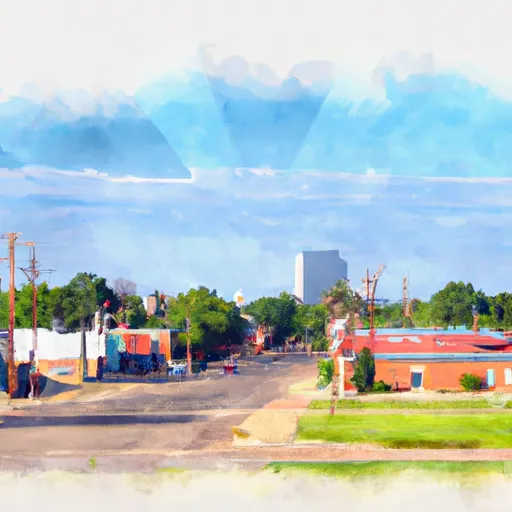-
 Snoflo Premium
Snoflo Premium
Get unlimited access to all our content
With no Ad interruptions! - Start Your Free Trial Login with existing account
Rentiesville
Eden Index
Climate
8.3
•
Recreation
2.9
•
Community
•
Safeguard
4.3/10

Rentiesville, Oklahoma is a small town located in McIntosh County, in the southeastern part of the state. The town experiences a humid subtropical climate, characterized by hot summers and mild winters. Summers are typically hot and humid with temperatures reaching into the high 90s (Fahrenheit), while winters are generally mild with temperatures rarely dropping below freezing.
Hydrologically, Rentiesville lies within the Arkansas River watershed. The Arkansas River, which flows nearby, provides a water source for the area and supports various aquatic life. The region also has several small creeks and ponds that contribute to the local hydrology.
For outdoor enthusiasts, Rentiesville and its surrounding areas offer several recreational opportunities. The nearby Greenleaf State Park provides opportunities for camping, hiking, fishing, and boating on Greenleaf Lake. The lake is abundant with bass, catfish, and crappie, attracting fishing enthusiasts. Additionally, the area is known for its beautiful landscapes, making it a great destination for nature photography and wildlife observation.
In summary, Rentiesville, Oklahoma experiences a humid subtropical climate, is situated within the Arkansas River watershed, and offers outdoor activities such as camping, fishing, boating, hiking, and wildlife observation.
What is the Eden Index?
The Snoflo Eden Index serves as a comprehensive rating system for regions, evaluating their desirability through a holistic assessment of climate health, outdoor recreation opportunities, and natural disaster risk, acknowledging the profound impact of these factors on livability and well-being.
Climate Health Indicator (CHI): 8.3
Rentiesville receives approximately
1116mm of rain per year,
with humidity levels near 81%
and air temperatures averaging around
16°C.
Rentiesville has a plant hardyness factor of
7, meaning
plants and agriculture in this region tend to thrive during the non-winter months.
By considering the ideal temperature range, reliable water supplies, clean air, and stable seasonal rain or snowpacks, the Climate Health Indicator (CHI) underscores the significance of a healthy climate as the foundation for quality living.
A healthy climate is paramount for ensuring a high quality of life and livability in a region, fostering both physical well-being and environmental harmony. This can be characterized by ideal temperatures, reliable access to water supplies, clean air, and consistent seasonal rain or snowpacks.
Weather Forecast
Streamflow Conditions
Robert S. Kerr Reservoir
Area Rivers
Robert S. Kerr Reservoir
Snowpack Depths
Robert S. Kerr Reservoir
Reservoir Storage Capacity
Robert S. Kerr Reservoir
Groundwater Levels
Recreational Opportunity Index (ROI): 2.9
The Recreational Opportunity Index (ROI) recognizes the value of outdoor recreational options, such as parks, hiking trails, camping sites, and fishing spots, while acknowledging that climate plays a pivotal role in ensuring the comfort and consistency of these experiences.
Access to outdoor recreational opportunities, encompassing activities such as parks, hiking, camping, and fishing, is crucial for overall well-being, and the climate plays a pivotal role in enabling and enhancing these experiences, ensuring that individuals can engage in nature-based activities comfortably and consistently.
Camping Areas
| Campground | Campsites | Reservations | Toilets | Showers | Elevation |
|---|---|---|---|---|---|
| Rattan Landing - Hugo Lake | None | 433 ft | |||
| Hugo Lake - Kiamichi State Park | None | 468 ft | |||
| Sardis Cove | None | 688 ft | |||
| Sanders Cove - Pat Mayse Lake | 90 | 541 ft | |||
| Pat Mayse East - Pat Mayse Lake | 25 | 504 ft | |||
| Pat Mayse West - Pat Mayse Lake | 85 | 481 ft | |||
| Lamar Point - Pat Mayse Lake | None | 506 ft | |||
| Virgil Point - Hugo Lake | None | 452 ft | |||
| Clayton Lake State Park | None | 738 ft | |||
| Kiamichi Park - Hugo Lake | None | 464 ft |
Nearby Fishing
Catastrophe Safeguard Index (CSI):
The Catastrophe Safeguard Index (CSI) recognizes that natural disaster risk, encompassing floods, fires, hurricanes, and tornadoes, can drastically affect safety and the overall appeal of an area.
The level of natural disaster risk in a region significantly affects safety and the overall livability, with climate change amplifying these risks by potentially increasing the frequency and intensity of events like floods, fires, hurricanes, and tornadoes, thereby posing substantial challenges to community resilience and well-being.
Community Resilience Indicator (CRI):
The Community Resilience Indicator (CRI) recognizes that education, healthcare, and socioeconomics are crucial to the well-being of a region. The CRI acknowledges the profound impact of these elements on residents' overall quality of life. By evaluating educational resources, healthcare accessibility, and economic inclusivity, the index captures the essential aspects that contribute to a thriving community, fostering resident satisfaction, equity, and social cohesion.

